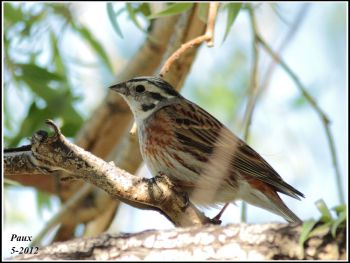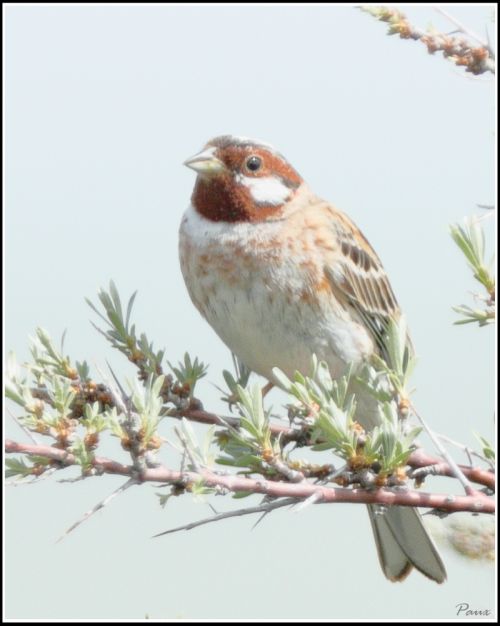(References updated) |
m |
||
| (6 intermediate revisions by 2 users not shown) | |||
| Line 1: | Line 1: | ||
| − | [[ | + | [[File:BF Pine Bunting Paux.jpg|thumb|500px|right|Photo © by {{user|paux|paux}}<br />[[Kazakhstan]], May, 2019]] |
| − | + | ||
;[[:Category:Emberiza|Emberiza]] leucocephalos | ;[[:Category:Emberiza|Emberiza]] leucocephalos | ||
==Identification== | ==Identification== | ||
| − | 16-17.5cm<br /> | + | [[Image:Pine_Bunting.jpg|thumb|550px|right|Photo © by {{user|Dave+Hawkins|Dave Hawkins}}<br />Chosely, [[Norfolk]], March 2004]] |
| + | 16-17.5cm (6¼-7 in)<br /> | ||
*White crown and cheeks | *White crown and cheeks | ||
*Chestnut forehead and throat with dark streaks<br /> | *Chestnut forehead and throat with dark streaks<br /> | ||
| Line 9: | Line 10: | ||
Seems to be rather variable in extent of white versus rufous in the head | Seems to be rather variable in extent of white versus rufous in the head | ||
====Similar species==== | ====Similar species==== | ||
| + | [[Image:IMG 29042.jpg|thumb|350px|right|Female , Summer Plumage<br />Photo © by {{user|Houman+Doroudi+(Tormtay)|Houman Doroudi (Tormtay)}}<br />Lar National Park, Mazandaran Province, [[Iran]], May 2017]] | ||
Female [[Yellowhammer]] usually has yellow tones, but on a few, these may be very faint and therefore difficult to separate. To identify female Pine Bunting (which should look more contrasting overall), look especially that | Female [[Yellowhammer]] usually has yellow tones, but on a few, these may be very faint and therefore difficult to separate. To identify female Pine Bunting (which should look more contrasting overall), look especially that | ||
| − | *outer edges of primaries are white | + | *outer edges of [[Topography#Wings|primaries]] are white |
*outer edges of outer tail feathers are white (especially proximal part) | *outer edges of outer tail feathers are white (especially proximal part) | ||
*lower belly white without yellow or golden tones | *lower belly white without yellow or golden tones | ||
| − | *underwing coverts are white without any yellow | + | *underwing [[Topography#General Anatomy|coverts]] are white without any yellow |
*no yellow or olive-green tones to the plumage | *no yellow or olive-green tones to the plumage | ||
*tendency for two-toned bill, paler on lower than upper mandible | *tendency for two-toned bill, paler on lower than upper mandible | ||
| − | On both sexes, note that the rump is more brownish lacking the orange tone to the rufous that many Yellowhammer shows. | + | On both sexes, note that the rump is more brownish lacking the orange tone to the rufous that many Yellowhammer shows. |
| + | |||
| + | Hybrids, crossed with Yellowhammer are common. | ||
==Distribution== | ==Distribution== | ||
| + | [[Image:Pine_Buntingp.jpg|thumb|350px|right|Hybrid Pine Bunting X Yellowhammer. Note the white supercilium, face and throat (where a Yellowhammer would be yellow). Pure male Pine has throat etc rufous. In addition, the rufous breast is restricted to the pectorals and the flank streaking is black versus rufous in Pine<br>Photo © by {{user|paux|paux}}. N. Xinjiang, [[China]]]] | ||
[[Asia]]: found from [[Siberia]] to north [[India]] and southern [[China]]. | [[Asia]]: found from [[Siberia]] to north [[India]] and southern [[China]]. | ||
| Line 33: | Line 38: | ||
==Behaviour== | ==Behaviour== | ||
====Diet==== | ====Diet==== | ||
| − | + | During the breeding season, their diet consists mostly of insects and invertebrates such as grasshoppers, caterpillars and beetles, with seeds the remainder of the year. | |
====Breeding==== | ====Breeding==== | ||
| − | The 4-6 eggs are | + | The clutch consists of 4-6 eggs. The nest is a woven cup built by the female. There are usually two broods. |
==References== | ==References== | ||
| − | #{{Ref- | + | #{{Ref-Clements6thOct22}}#Handbook of the Birds of the World Alive (retrieved October 2016) |
{{ref}} | {{ref}} | ||
==External Links== | ==External Links== | ||
| − | {{GSearch|Emberiza | + | {{GSearch|"Emberiza leucocephalos" {{!}} "Pine Bunting"}} |
| + | {{GS-checked}}1 | ||
| + | <br /> | ||
| + | <br /> | ||
| + | |||
[[Category:Birds]][[Category:Emberiza]] | [[Category:Birds]][[Category:Emberiza]] | ||
Latest revision as of 09:17, 21 August 2023
- Emberiza leucocephalos
Identification
16-17.5cm (6¼-7 in)
- White crown and cheeks
- Chestnut forehead and throat with dark streaks
Female is duller and is more streaked on undersides
Seems to be rather variable in extent of white versus rufous in the head
Similar species

Photo © by Houman Doroudi (Tormtay)
Lar National Park, Mazandaran Province, Iran, May 2017
Female Yellowhammer usually has yellow tones, but on a few, these may be very faint and therefore difficult to separate. To identify female Pine Bunting (which should look more contrasting overall), look especially that
- outer edges of primaries are white
- outer edges of outer tail feathers are white (especially proximal part)
- lower belly white without yellow or golden tones
- underwing coverts are white without any yellow
- no yellow or olive-green tones to the plumage
- tendency for two-toned bill, paler on lower than upper mandible
On both sexes, note that the rump is more brownish lacking the orange tone to the rufous that many Yellowhammer shows.
Hybrids, crossed with Yellowhammer are common.
Distribution

Photo © by paux. N. Xinjiang, China
Asia: found from Siberia to north India and southern China.
Accidental vagrant to Alaska with 2 records.
Taxonomy
Subspecies
There are 2 subspecies[1]:
- E. l. leucocephalos:
- E. l. fronto:
- North-western China (Kokonor region of north-eastern Qinghai to north-western Gansu)
Habitat
Open pine forests; fields with hedges, scrub or trees.
Behaviour
Diet
During the breeding season, their diet consists mostly of insects and invertebrates such as grasshoppers, caterpillars and beetles, with seeds the remainder of the year.
Breeding
The clutch consists of 4-6 eggs. The nest is a woven cup built by the female. There are usually two broods.
References
- Clements, J. F., T. S. Schulenberg, M. J. Iliff, T. A. Fredericks, J. A. Gerbracht, D. Lepage, S. M. Billerman, B. L. Sullivan, and C. L. Wood. 2022. The eBird/Clements checklist of Birds of the World: v2022. Downloaded from https://www.birds.cornell.edu/clementschecklist/download/
- Handbook of the Birds of the World Alive (retrieved October 2016)
Recommended Citation
- BirdForum Opus contributors. (2024) Pine Bunting. In: BirdForum, the forum for wild birds and birding. Retrieved 19 May 2024 from https://www.birdforum.net/opus/Pine_Bunting
External Links
GSearch checked for 2020 platform.1





